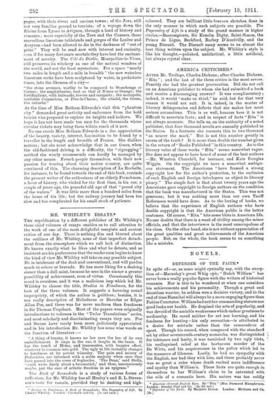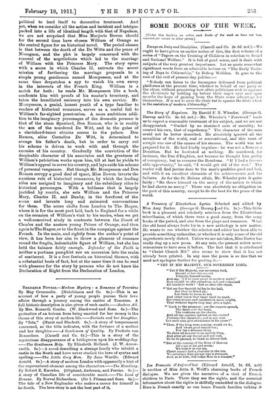NOVELS.
DEFENDER OF THE FAITH.*
IN spite of—or, as some might cynically say, with the excep- tion of—Macaulay's great Whig epic, "Dutch William" has never been a really popular figure with the writers of historical romance. Nor is this to be wondered at when one considers his achievements and his personality. Though a great and dauntless warrior, he seldom won a decisive victory, and to the end of time Hannibal will always be a more engaging figure than Fabius Cunctator. William had neither commanding stature nor good looks nor health. He despised the arts of popularity, and was devoid of the amiable weaknesses which endear greatness to mediocrity. He cared neither for art nor learning, and his fondness for hunting—his only recreation—is attributed to a desire for solitude rather than the camaraderie of sport. Though his record, when compared with the standard set by other seventeenth-century monarchs, was distinguished for tolerance and lenity, it was tarnished by two ugly blots, his undisguised relief at the barbarous murder of the De Wilts, and his acquiescence in the policy which led to the massacre of Glencoe. Lastly, he had no sympathy with the English, nor had they with him, and there probably never was so great a ruler whose death excited more indifference and apathy than William's. These facts are quite enough in themselves to bar William's claim to be entrusted with the role of a romantic hero. His nature was too coldly • America—through English Eyes. By "Rita " (Mrs. Desmond Humphreys). London Stanley Paul and Co. 12s. 6d. net.] • Defender of the Faith. By Marjorie Box en. London : Methuen and Co. [68.) political to lend itself to decorative treatment. And yet, when we consider all the action and incident and intrigue packed into a life of identical length with that of Napoleon, we are not surprised that Miss Marjorie Bowen should for the second time have chosen William of Orange as the central figure for an historical novel. The period chosen is that between the death of the De Witte and the peace of Nimeguen, and the plot is largely concerned with the renewal of the negotiations which led to the marriage of William with the Princess Mary. The story opens with a scene in which Charles II. entrusts the secret mission of furthering the marriage proposals to a simple young gentleman named Mompesson, and at the same time despatches a spy to watch his own envoy in the interests of the French King. William is a match for both : he reads Mr. Mompesson like a book, confronts him with proofs of his master's treachery, and takes the humiliated emissary into his own service. Mr. Mompesson, a genial, honest youth of a type familiar to readers of historical romances, serves as a useful foil to William's farsighted penetration. A more ambitious addi- tion to the imaginary personages of the dramatis persona is that of the sham $paniard, Don Ramon, who is in reality the son of the murdered De Witt, and in the guise of a clavichord-tuner obtains access to the palace. Don Ramon, alias Cornelius De Witt, is determined to avenge his father's death, but in order to carry out his scheme is driven to work with and through the enemies of his country. Gradually the conviction of the despicable character of his associates and the greatness of William's patriotism works upon him, till at last he yields to William's appeal to serve his country, and lays aside his scheme of personal vengeance. But though Mr. lelompesson and Don Ramon occupy a good deal of space, Miss Bowen inverts the cautious rule of historical romancers, by which the leading roles are assigned to imaginary and the subsidiary roles to historical personages. With a boldness that is largely justified by results, she sets William and the Princess Mary, Charles IL and Denby, in the forefront of the same and invents long and animated conversations for them. The scene shifts from London to The Hague, where it is for the most part laid, back to England for a. while on the occasion of William's visit to his uncles, when we get a well-conceived study in contrasts between the Court of Charles and the austere young Prince of Orange, and then again to The Hague, or to the front in the campaign against the French. In the main, and rightly from the author's point of view, it has been her aim to throw a glamour of romance round the fragile, indomitable figure of William, but she has held the balance fairly enough. Defender of the Faith is neither a partisan pamphlet nor an excursion into the realm of sentiment. It is a free fantasia on historical themes, with a substantial basis of fact, but at the same time it can be read with pleasure for the story by persons who do not know the Declaration of Right from the Declaration of London.







































 Previous page
Previous page